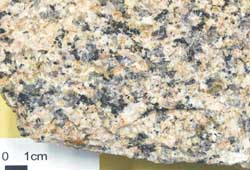There are 3 types of rocks: igneous, sedimentary and metamorphic and this is how they form.
Formation of igneous rocks
Igneous rock forms when hot liquid rock called magma cools. When the magma cools below the Earth's surface it cools slowly  forming large crystals and is known as an intrusive igneous rock e.g. granite (pictured to the right). When magma reaches the Earth's surface, usually through a volcano, it is called lava and it cools quickly, rocks formed by this process are known as extrusive igneous rock e.g. basalt.
forming large crystals and is known as an intrusive igneous rock e.g. granite (pictured to the right). When magma reaches the Earth's surface, usually through a volcano, it is called lava and it cools quickly, rocks formed by this process are known as extrusive igneous rock e.g. basalt.
Igneous rocks may have been metamorphic or sedimentary rocks before melted and reforming magma.
We have many granite bodies exposed at the surface in Ireland including the Leinster and Galway Granites. They formed below the surface of the earth but where brought to the surface either through erosion of the overlying material or due to the movement of faults.
Formation of sedimentary rocks
Sedimentary rock forms when small particles known as sediment build up layer upon layer and pressure causes them to compress and cement together over time.
When rocks are weathered and eroded the resulting sediment is transported by various means (e.g. river, glacier, gravity), and finally deposited into layers before it is buried and becomes a sedimentary rock. The red sandstones and conglomerates (pictured right) in Cork and Kerry formed in this way.

Limestone makes up a large portion of the bedrock of Ireland and is composed of Calcium Carbonate from the remains of marine animals and sea water.
A limestone from Ireland containing fossils is shown to the right.
Formation of metamorphic rocks
Metamorphic rock has been changed by heat and pressure. If igneous, sedimentary or other metamorphic rocks are exposed to elevated heat and pressure, they will change form. This process does not melt the rock but changes the rock by growing new crystals from the original composition of the rock. Often the crystals lie in a particular direction due to the pressure. This change is known as metamorphism and the rock becomes a metamorphic rock. e.g. limestone becomes marble with an increase in temperature and pressure (pictured right). Metamorphism often occurs in response to high tectonic activity for example the collision of two plates. Most of Connemara in west Galway is metamorphic and Connemara marble is famous.